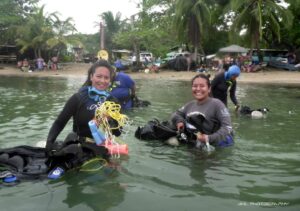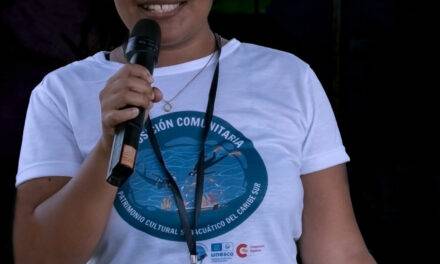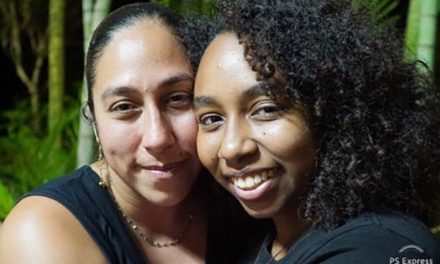María Suárez Toro, CCBEM
May 25, 2023
An important discovery was made by the Ambassadors of the Sea, Maraya Jiménez Taysigue and Ana María Arenas Moreno while acting as assistants to underwater archeologists doing photogrammetry in the Cahuita National Park (PNC) during the Expedition (see final Report here).
Photo: Ana Maria (left) and Maraya (right),
foto by Ocean Soul Divers, 2023
Their finding is an exciting example of new relational citizen science, a science produced by citizens who link scientific knowledge with ancestral knowledge.
On the morning of May 18, 2023, at the Anchors and Canyons Site in the PNC, both scuba divers dove into the waters to discover an array of hundreds of bricks from the shoreline out to the shipwrecks. Their finding was an important clue to testing the hypotheses about the identity of the sunken ships, the primary focus of the current maritime archaeological projects in that area. Although research had focused on the bricks, Maraya and Ana María found hundreds of bricks dispersed along the end of the wreck stretching to the shoreline.
The finding seems to be another example of the “organic” way in which women do science, as explained here later.
With this discovery, the two women helped solved the enigma that had been missing to prove that the wreck in that site of the PNC definitely corresponds to a second Danish ship that ran aground against the coral reef in 1710. The large amount of unorganized bricks served as additional evidence.
The documented account of the second Danish ship states that the Christianus V. had been set adrift by slaves and sailors until colliding with the reef.
The main archeological hypothesis crafted and researched over five consecutive Expeditions stewarded by Ambassadors of the Sea between 2016 and the present, relates to two Danish slave ships, the Fredericus IV and the Christianus V. Evidence is showing that the first ship was burned and the second set adrift by enslaved persons and sailors who mutinied on board after sending everyone else to safety on shore – the African men, women and children – and in a separate barge – the captains, sailors and 22 Africans.
Along with the Africans, it is hyposthesized that the ships each carried approximately 44,000 Danish bricks used as ballast on board, or for other uses such to construct kitchens on the ships.
A photogrametry map shows evidence that the burned Fredericus IV might be the wrecked remains in the Brick Site. The perfect layout of the hundreds of bricks on the sand, over a hump shaped like the bottom of a ship, might be the remains of that ship.
But the other wreck, located 1 km. away from the Brick Site, an area known as the Anchors and Cannon Site, also under documentation as part of the hypothesis, presented no evidence yet of a large amount of bricks that should be there if the remains are those of the other ship, the Christianus V.
The Findings
The morning of May 18, 2023, Maraya and Ana María, both assistants in a photogrammetry mapping procedure with international archaeologists, jumped into the sea to explore the connections among all the findings of previous years by examining patterns of the bricks. They identified hundreds of thousands of bricks in a messy path to the beach, which provided additional evidence of the “yellow brick road” in the the Anchors and Canyons Site.
This important discovery by the two assistants has confirmed that there were indeed two shipwrecks, not one, which constitutes a tremendous contribution to testing the hypothesis about the two Danish slave ships who arrived and were shipwrecked together in the Costa Rican Caribbean.
The uproar that broke out in the boat guided by “Capi” and his crew of five archaeologists was tremendous. They had been filming loose bricks between two anchors and around 15 cannons for several hours.
Until then it was considered impossible – unless thousands of bricks were found – that it was a second ship that dropped those anchors and cannons a kilometer away from the Brick Sites where there are thousands of other bricks, belonging to a burned ship.
“Finding these bricks at the Anchor and Brick Site helps verify that this was the shipwreck of a second ship, most likely the Christianus V,” said Danish archaeologist Andreas Bloch. “Thousands of bricks could not have totally disappeared over the course of the 313 years since the arrival of the ships in 1710. It was an enigma to be solved – said the Danish archaeologist Andreas Bloch – stating that the two Ambassadors of the Sea finally solved the mystery by finding a path of so many bricks on the site.”
The two female divers say that they connected the information that their fellow Ambassadors of the Sea had told them about the previous Expeditions, their their knowledge about the coral reef in the area, and what they have learned about the loading of ships in courses they took with the Nautical Archeology Society (NAS).
“If the ship released cannons at 50 – 60 meters and anchors at 30 – 40 meters from shore, the last thing it released when it hit the reef must have been the bricks in the bottom of the boat, with a trajectory towards the shore as it was being pushed by the waves while drifting and being torn apart,” said Maraya.
Compiling this information, Maraya and Ana María then set out to observe the area near the shoreline of the beach, discovering a vast quantity of scattered bricks, most likely from the ship’s collision with the reef.
Women’s Discoveries in Science Follow a Different Logic
Se reel about the diving in the site: https://www.facebook.com/centrodebuceocaribesur/videos/1317923895464208/?extid=WA-UNK-UNK-UNK-IOS_GK0T-GK1C&mibextid=2Rb1fB
For me, as the coordinator of the cultural research project in which the discovery of these two women is framed, their finding did not happen by chance.
My 2005 research on women’s contributions to science throughout history, published in the book, Mujeres Metamorfósis del Efecto Mariposa” (Women’s Metamorphosis as the Butterfly Effect) documents that they have made substantial holistic contributions to science in all corners of the world, at all times of life, and in all disciplines of knowledge, because they focus more on relationships than on isolated objects or facts, or what I call the new relational citizen science.
This was the case of Albert Einstein’s first wife, Mileva Marić, who contributed the mathematics for the research for the Nobel Prize that he won for the photoelectric effect without giving her credit, having deleted her name from the work.
This was also the case of the Afro-American women who created the FORTRAM computer program in NASA, Katherine Johnson, Dorothy Vaughan, and Mary Jackson were programming pioneers, although they have been recognized recently.
Another example of women’s scientific work getting erased in history was the case of Lynn Margulis, with her thesis of the symbiotic planet that proves that life was born here on this planet, a product of the relationship and fission between nuclei of unicellular organisms. In contrast, her then husband, the famous Carl Sagan, maintained that life had come from another planet. It was difficult for the scientific community to believe Margulis over the voice of her famous husband, so her work was dissappeared.
And so on, hundreds of cases that lead me to affirm today with great pride, that although some women scientists were recognized for their contributions decades and centuries after having made them, for me – with great honor – with this finding, Maraya and Ana María have become part of that legacy of the new relational citizen science.
Fortunately, our international archaeologists are not like the husbands or chiefs of staff of those women in the past who made tremendous scientific discoveries in history without having been publicly recognized.
Quite the contrary, our invited international archeologists immediatly celebrated the constrivution of the the women.
 Their discovery was publicly recognized by Dr. Kotaro Yamafune (Japan) and MSc. Andreas Boch (Denmark) at the virtual press conference a few days later. (See broadcast on Embajadores del Mar Facebook.)
Their discovery was publicly recognized by Dr. Kotaro Yamafune (Japan) and MSc. Andreas Boch (Denmark) at the virtual press conference a few days later. (See broadcast on Embajadores del Mar Facebook.)
Supplementary Story 3:
Who are the female citizen scientists?
Name Maraya Jimenez Taysigue, 22 years old
Secretary of the CCBEM Board of Directors
Studies: Bachelor of Secondary Education at the Puerto Viejo Rural Lyceum.
Law student at the University of Costa Rica. Celebrating the achivement, Photo by CCBEM
Professional massage at COSVIC and at Beauty Ritual.
Profession: Professional masseuse.
Trainings
- PADI Open Water
- Peak Performance Buoyancy 2023
- Introductory Course to Nautical Archeology – NAS INTRO – OCT 2019 Taught by archaeologists from the University of Carolina del Este.
- Induction in Corals 2022 taught by CCBEM – PRONAMEC criteria, techniques and methods to monitor corals
Ana Maria Arenas, 44 years old.
Coordinator of the Choral and Communication Commission of the CCBEM Networks, graphic designer
Third year of history at the University of Costa Rica Training
Trainings
- Padi Rescue
- Padi Advance
- Padi Open Water
- For PADI DIVE MASTER, in November presented final credentials to graduate from Dive Master
- Photogrammetry 2019 given by Kotaro Yamafune archaeologist from Japan and Matko Čvrljak, archaeologist from Croatia
- Introductory Course to Nautical Archeology (NAS INTRO), October 2019 Taught by the Danish archaeologist Andreas Bloch
- Coral Induction 2020 taught by Innoceana – PRONAMEC criteria, techniques and methods to monitor corals, instruments and protocols to identify corals and invertebrates.
- Virtual Course: Identification, Monitoring and Planting of Corals 2021 – taught online by Diving with a Purpose
- PADI AWARE Certification – Project AWARE Specialty Course 2021
- Workshop Creation Updated Base Line Corals in Puerto Viejo Reef taught by Biologist Isaac Baldizón
- Nautical Archeology Course – NAS 1 – 2021 Taught by the Danish archaeologist Andreas Bloch




